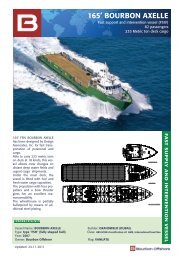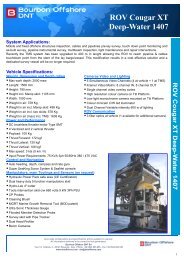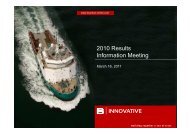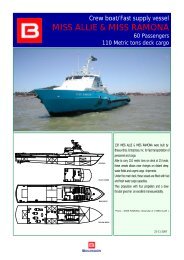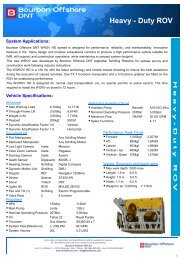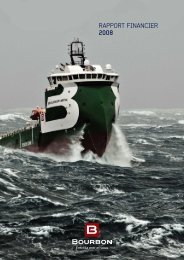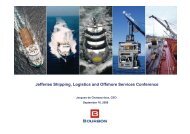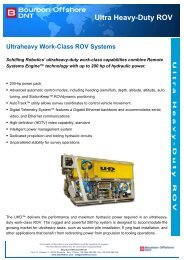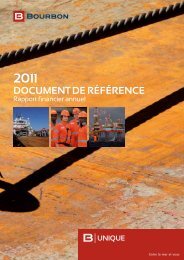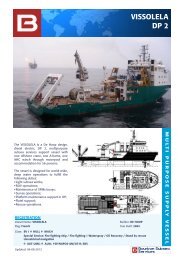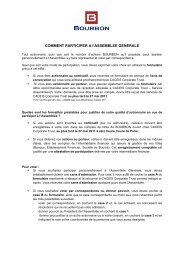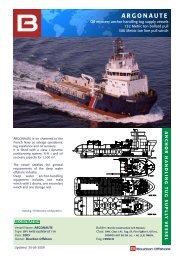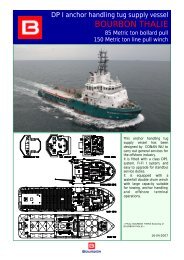REGISTRATION DOCUMENT - Bourbon
REGISTRATION DOCUMENT - Bourbon
REGISTRATION DOCUMENT - Bourbon
- No tags were found...
Create successful ePaper yourself
Turn your PDF publications into a flip-book with our unique Google optimized e-Paper software.
3RiskMANAGEMENT REPORTfactors4.1.1 Risks related to changes in demandA reduction in investments in the oil sector could result ina decline in demand for offshore oil and gas services andtherefore limit BOURBON’s capacity to increase or maintainits profits.The demand for offshore oil and gas services is dependent on the oilcompanies’ capacity to invest. The price of oil on world markets hasa signifi cant infl uence over decisions to engage in new investmentsin this sector. In fact, new investment projects are based on futureprojections, internal to each company, of the price per barrel that willbe needed to cover the cost of extraction. The price of oil in the shortterm has a lesser infl uence once oil projects have been launchedand in the production phase. The potential impact remains limitedto exploration phases which may be delayed or even cancelled.Generally, oil investment cycles are long, between 10 and 20 yearson average between the construction phase and the exploitation/production phase.The price per barrel depends on demand, which is related to globalgrowth and the production capacity of the producing countries. Therisk of a long-term downward price trend is very low. With forecastsfor an increase in demand for oil and the accelerating decline inproduction at existing fi elds, the oil services activity is expected togrow in the medium and long term. Should market forecasts changesignifi cantly in comparison with BOURBON’s current forecasts, itsbusiness, fi nancial position, results or outlook could be affected.BOURBON’s strategy is to develop close ties with the national andinternational oil majors that have sustained investment plans and toplace particular importance on a policy of long-term contractualizationof BOURBON vessels. At December 31, 2011, 67% of offshoresupply vessels were under long-term contracts, with the averageresidual duration of contracts for these vessels of 14.5 months.At the same time, the implementation of an active managementapproach to monitoring vessels working in production or explorationmakes it possible to react quickly depending on market movements.The loss of one or more of its main clients could, however, havea signifi cantly prejudicial effect on BOURBON’s business, fi nancialposition, results or outlook.Risks related to changes in technical requirements for marineoil exploitation and related services.Oil companies generally prefer cutting-edge, high performancevessels like those belonging to the BOURBON fl eet. The rate ofreplacement of old vessels in order to meet oil companies’ stringent“risk management” requirements is accelerating. In 2011, the worldfl eet utilization rate of vessels more than 25 years old, fell below50% (1) confi rming the need to renew old vessels with modern onesthat meet new requirements in terms of safety at sea.BOURBON has established long-term relationships with majoroil companies, thereby enabling it to better understand theirexpectations. This has led BOURBON to develop a four-pillar modelof operational excellence i.e. safety, personnel’ s skills, reliability andavailability and costs optimization (which includes using low fuelconsumption diesel-electric propelled vessels. BOURBON cannot,however, guarantee that it will always be able to perfectly predictits clients expectations, nor can it discount the fact that, in oneor more of the geographical areas where it has a presence, someof its competitors may, due to their size or expertise, have at theirdisposal fi nancial, commercial, technical or human resources thatare equivalent, or superior, to those offered by BOURBON and thatare also likely to meet the requirements of the major oil companies,which could, under certain circumstances, lead to market losses forBOURBON.4.1.2 Risks related to changes in supplyOn the deepwater offshore vessels market, in the event ofnew ships being delivered faster than the growth in demand,BOURBON may experience temporary over-capacity aswell as a drop in daily and utilization rates for its deepwateroffshore vessels in certain geographical regions.Growth in the deepwater offshore market is steady at 7% (1) , graduallyattenuating the over-capacity recorded previously. Exposure to thisrisk is limited since BOURBON’S program of investment in thesetypes of vessels is limited (only three PSVs and one AHTS will bedelivered in 2012).In terms of geographic positioning, BOURBON is well placed toresist over-capacity as it has low exposure to the most competitivemarket of the North Sea, no presence in the US territorial watersof the Gulf of Mexico, and with a dominant position in West Africa.It should also be noted that Brazil is currently helping to regulatethe situation due to its constant and extremely sustained demand,which is absorbing some of the overcapacity of the new deepwateroffshore fl eet of vessels.In addition, BOURBON’s commercial strategy focuses on “longterm”contracts, which minimizes the risks of exposure to short-termmarket fl uctuations.Despite these different measures, BOURBON cannot discount thefact that temporary over-capacity could cause a fall in daily ratesas well a drop in rates of utilization of its vessels, likely to have aprejudicial effect on its business, its fi nancial position, its results orits outlook.(1) Source: BOURBON/ODS Petrodata.38BOURBON - 2011 Registration Document



